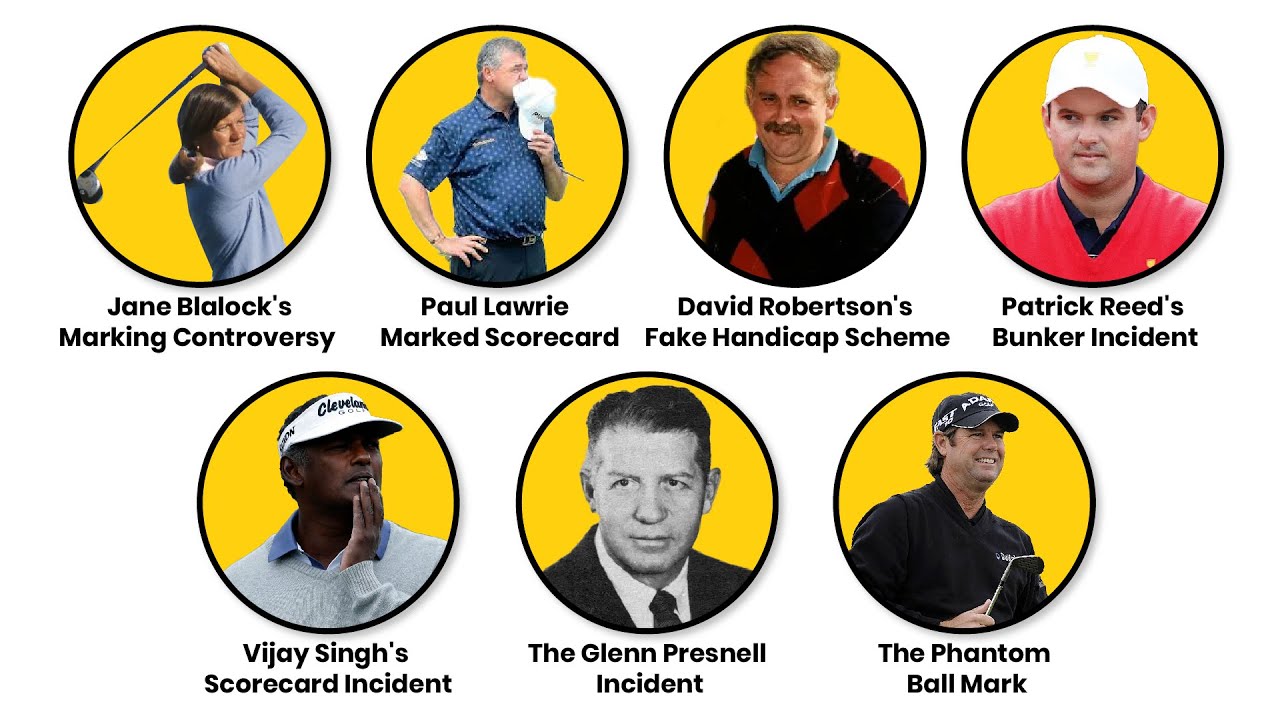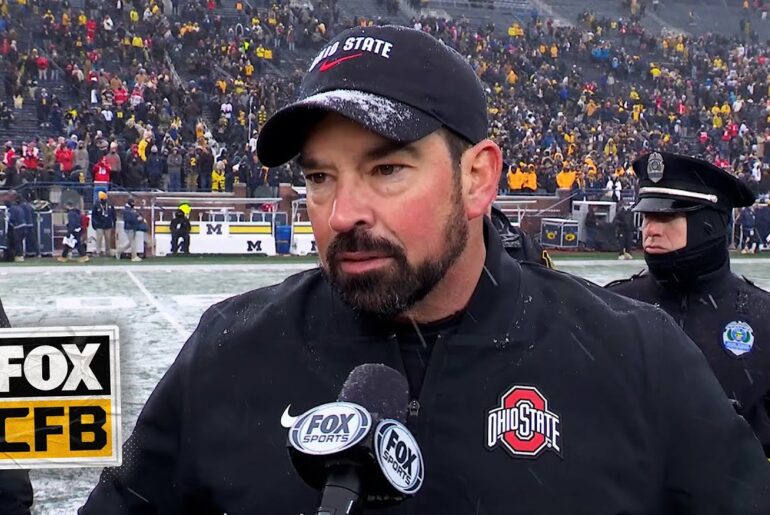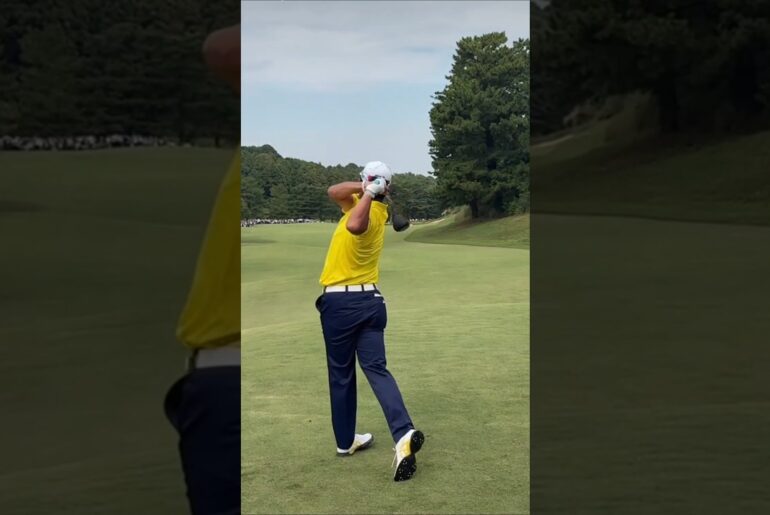The Biggest Cheating Scandals in Golf History — What Really Happened
Golf is a sport built on honor—but what happens when that trust is broken? From scorecard tampering and fake handicaps to bunker blunders caught on HD cameras, this video dives into the most shocking cheating scandals in golf history. These weren’t minor infractions. They were deliberate attempts to gain an edge in a sport where integrity is everything.
📍 What You’ll Learn:
How Jane Blalock’s alleged ball-marking scandal shook the LPGA and led to major legal reforms
The bizarre case of David Robertson’s fake handicap and phantom golf club
Patrick Reed’s infamous bunker penalty and the viral fallout
Vijay Singh’s scorecard controversy that never fully went away
Why Glenn Presnell had a friend sneak his ball onto the green
The surprising “rock-moving” incident that nearly tarnished Paul Azinger
Some of these players remain legends. Others were erased from the game. But each one forced golf to re-examine what it means to compete with honor.
💬 Which of these scandals shocked you the most? Let us know in the comments and subscribe for more deep dives into golf’s untold stories.
Golf prides itself on being the only major sport where players call penalties on themselves. It’s a game built on honor, integrity, and self-regulation. But what happens when players break that sacred trust? From major champions caught improving their lives to elaborate schemes involving fake scorecards, golf’s history is dotted with shocking incidents of cheating that rocked the sport to its core. In this video, I’ll break down the most egregious cheating scandals in golf history. the deliberate rule violations and deceptions that change tournaments, careers, and the game itself. These aren’t innocent mistakes or misunderstandings of complex rules. They’re calculated attempts to gain unfair advantages in a sport that depends on honesty. And the most shocking part, some of these cheaters are still celebrated in golf history. Their transgressions quietly forgotten by a sport eager to protect its reputation. Jane Bllelock’s marking controversy. In 1972, LPGA player Jane Bllelock was accused of one of the most fundamental breaches in golf. Incorrectly marking and replacing her ball on the green to improve her position. After multiple players reported suspicious behavior, LPGA officials secretly observed Bllelock during the Bluegrass Invitational in Louisville. Officials claimed they witnessed Bllelock marking her ball, then replacing it in a slightly different position that gave her an advantage. She was disqualified from the tournament and subsequently suspended for one year by the LPGA executive board. What made this case extraordinary was Bllelock’s response. Rather than accepting the punishment, she filed a $5 million antirust lawsuit against the LPGA, arguing the organization had acted as both prosecutor and judge, denying her due process. A federal court agreed, issuing an injunction that allowed her to continue playing while the case proceeded. The scandal divided the women’s tour. Some players refused to be paired with Bllelock, while others publicly supported her. The controversy threatened the very existence of the fledgling women’s tour, which was already struggling for recognition and sponsorship. Eventually, the case was settled out of court with the LPGA agreeing to establish more formal disciplinary procedures and Bllelock’s suspension being lifted. Bllelock went on to win 27 LPGA tournaments, but the cheating allegations followed her throughout her career despite never being conclusively proven in a court of law. The scandal fundamentally changed how professional golf handles rules violations and disciplinary matters. Both the LPGA and PGA Tour established more transparent processes with clear appeal procedures. Recognizing that even in the gentleman’s game, accusations require due process and fair hearings. Paul Lori and the marked scorecard. At the 1992 Portuguese Open, Scottish golfer Paul Luri was disqualified after tournament officials discovered that his caddy had altered his scorecard. The caddy had changed a seven to a four on one hole, significantly improving Lor’s score. What makes this case unusual is that Lorie himself was completely unaware of the alteration. His caddy had made the change without his knowledge, apparently hoping to help his employer make the cut. When the discrepancy was discovered, Lorie was devastated, but accepted the disqualification without protest. The incident highlighted the vulnerability of golf’s scoring system and led to stricter procedures for handling and reviewing scorecards. It also demonstrated the principle that players are responsible for their scorecards regardless of who makes an error, even if that error is deliberate deception by someone else. Lor’s reputation remained intact because of his immediate acceptance of the ruling and his obvious lack of involvement in the deception. He would go on to win the 1999 Open Championship at Carnoui, completing one of the greatest comebacks in major championship history, David Robertson’s fake handicap scheme. In 1985, British businessman David Robertson executed one of the most elaborate cheating schemes in amateur golf history. Robertson, a skilled golfer with a legitimate handicap of around five, created a fake identity and golf club to establish a fraudulent 17 handicap. Using this inflated handicap, Robertson entered and won the prestigious Sunningale Forsomes tournament, collecting significant prize money. His scheme was discovered when suspicious competitors investigated and found that his supposed home club didn’t actually exist. Robertson was banned from amateur golf for life by the Royal and Ancient Golf Club RNA. The scandal led to significant changes in handicap verification procedures for amateur tournaments with stricter requirements for documentation and confirmation of a player’s home club. This case demonstrated how the handicap system designed to level the playing field in amateur golf could be exploited by determined cheaters. It also highlighted the unique vulnerability of amateur tournaments where players often aren’t well known to officials and verification systems were less robust than in professional events. Patrick Reed’s bunker incident at the 2019 Hero World Challenge in the Bahamas. Patrick Reed was penalized two strokes after television cameras caught him improving his lie in a waste bunker. Slow motion replay showed Reed making two practice swings that cleared sand away from behind his ball, improving his path to the ball. Reed claimed the camera angle was misleading and that he hadn’t intended to improve his lie, saying, “After seeing the club go back and brush some sand, I had no idea it removed sand.” However, the penalty stood and Reed’s reputation, already controversial from previous incidents, suffered further damage. The incident became a major talking point in golf with players, commentators, and fans debating whether Reed’s actions were deliberate. Former PGA Tour player Mark Leashman commented, “I think there’s a little room for a benefit of the doubt, but that was pretty blatant. I don’t have much sympathy for that.” Reed’s reputation was further damaged at the following week’s President’s Cup in Australia, where fans heckled him with chance of Patrick cheat and mimicked shoveling motion. Rather than diffusing the situation, Reed antagonized the crowd by mimicking a shoveling motion with his putter after making a birdie. This controversy highlighted how modern television coverage with its highdefinition slow motion replays from multiple angles has made it virtually impossible for players to get away with rule violations that might have gone unnoticed in earlier eras. If you’re finding these cheating scandals fascinating, you’re going to want to see what’s coming next on this channel. I’m working on a deep dive into every golf rule controversy that changed history that will reveal the most disputed rulings that altered championships and careers. Hit that subscribe button and turn on notifications right now so you don’t miss it when it drops. These are the moments that prove how thin the line can be between strategic rule interpretation and outright cheating. Now, let’s get back to more shocking golf scandals that rock the sport. VJ Singh’s scorecard incident. Before becoming a PGA Tour star, VJ Singh was involved in one of golf’s most notorious cheating allegations in 1985. While playing on the Asian Tour, Singh was accused of altering his scorecard at the Indonesian Open to avoid missing the cut. According to reports, Singh changed a four to a one on his scorecard, significantly improving his score. When the alteration was discovered, Singh was suspended from the Asian Tour. This early controversy followed Singh throughout his career. Despite his remarkable achievements, 34 PGA Tour victories, three major championships, and 22 weeks as world number one. Singh has consistently denied the allegations, claiming there was a misunderstanding about his score. However, the incident has remained a shadow over his career, frequently mentioned whenever his name appears in Hall of Fame discussions. The case demonstrates how allegations of cheating, even from early in a player’s career, can permanently affect their reputation. Despite becoming one of the most accomplished players in PGA Tour history, Singh has never fully escaped the stigma of the Indonesian Open incident. The Glenn Presnell incident, one of the strangest cheating scandals in golf history occurred at the 1974 Tallahassee Open, where journeyman pro Glenn Presnell was disqualified for one of the most brazen violations imaginable. having his ball retrieved from a water hazard and placed on the green by an accomplice. Presnell’s T-shot on a par three had clearly entered the water, but when players reached the green, his ball was mysteriously sitting 20 ft from the hole. Suspicious players questioned Presnell, who initially claimed he had hit a second ball that reached the green. However, witnesses confirmed no such shot had been played. Tournament officials discovered that Presnell had arranged for a friend to retrieve his ball from the water and place it on the green while players were walking to the hole. He was immediately disqualified and subsequently suspended from the PGA tour. This incident stands out for its sheer audacity and the involvement of an accomplice, making it one of the most premeditated cheating attempts in professional golf. It also demonstrates the self-p policing nature of golf, as it was fellow competitors who first raised suspicions about the impossibly fortunate ball placement, the Phantom Ballark. At the 1991 Dural Ryder Open, Paul Azinger became embroiled in controversy when television cameras caught him improving his lie in a water hazard. Azinger’s ball had come to rest against a rock in shallow water. Before playing his shot, he appeared to move several small rocks, potentially improving his lie. When questioned about the incident, Azinger claimed he was only removing loose impediments, which would have been legal in a normal playing area, but not in a hazard. The PGA Tour chose not to penalize Azinger, accepting his explanation that he was unaware of the specific rule regarding hazards. The controversy intensified when the incident was repeatedly shown on television, with some commentators and players suggesting Azinger had received preferential treatment as a popular American player. The situation highlighted the subjective nature of intent in golf rules violations. Was this a deliberate attempt to cheat or simply a misunderstanding of a complex rule? Azinger’s reputation ultimately survived the controversy, partly because of his forthright response when confronted with the video evidence, and partly because of the sympathy he received during his subsequent battle with cancer. However, the incident remains a reminder of how thin the line can be between rule confusion and cheating. These cheating scandals reveal an uncomfortable truth about golf. Despite its reputation as a game of honor, the sport has seen its share of deliberate rulebreaking at the highest levels. From altered scorecards to improved lies, these incidents challenge golf’s self-image as a game where integrity trumps the desire to win. What makes cheating in golf particularly egregious is the sports reliance on player honesty. Unlike other sports where breaking rules might be seen as part of the game, if you can get away with it, golf’s tradition of self-regulation means that cheating violates the very foundation of the competition. Modern technology has made blatant cheating more difficult at the professional level. Highdefinition cameras, slow motion replay, and multiple angles mean that suspicious actions rarely go unnoticed. However, the subjective nature of intent still creates gray areas. Was that improved lie deliberate or accidental? Perhaps the most significant legacy of these scandals is how they’ve shaped golf’s approach to rule enforcement. From stricter scorecard procedures to clearer disciplinary processes, each major incident has led to reforms designed to protect the game’s integrity while ensuring fair treatment for accused players.








1 Comment
Removing comments now? Didn't realise AI could do that! Weak.